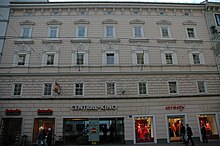Central Cinema (Linz)
The Central Kino was the longest-running cinema in the Upper Austrian capital Linz . It was located in the former Hotel Schiff , in the middle of the city center, on the main shopping street, Landstrasse . In 1897 a projection room was set up in the courtyard and the first film screenings “Living photographs in life size” were shown. As a permanent cinema, it was founded in 1909 as the second cinema in Linz and closed at the end of 2006.
history
prehistory
The establishment as a cinema was preceded by the first film screenings in the hotel's garden lounge. In March 1897, the traveling cinema owner Johann Bläser presented the city's first multi-day film program there. The only public film screening up until then was that of Karl Roithner in Roithner's Varieté in Waltherstrasse on September 1, 1896. Johann Bläser settled in Urfahr at the beginning of the 20th century , which was then still a suburb, now a district. After repeated problems with the room owner in the Hotel Schiff, because he broke the verbal lease and rented it to better paying, other bidders, Johann Bläser decided to buy the hotel and all of its rooms.
Opening of the cinema
After the purchase, Johann Bläser opened the second fixed cinema in the city of Linz with the bio-cinematograph . Just a few months after Karl Lifka founded the city's first fixed cinema, the Lifka cinema. Johann Bläser later renamed his cinema Blaser's Zentral-Kinematograph . He offered one show every day and two on weekends, each lasting around an hour and 15 minutes. However, no specific films were shown, but a weekly selection of short films, so-called one-reelers , from all over the world. To make the performances more attractive, simple, short street shots from Linz were also shown. His competitor Karl Lifka - instead of the former Lifka's Grand Théâtre électrique , later also simply Lifka-Kino , is now the trendy eatery Cheeese - on the other hand, offered two performances a day, and even four on weekends.
In 1920, Bläser sold the cinema and hotel to the Social Democratic Party in Upper Austria. This reopened the cinema in 1922 after being converted by Hubert Gessner as a central theater cinema .
Closure in the 98th year of operation
The cinema, which would have been 100 years old in 2009, was last operated by the Arbeiterheim business association (since 1920) and had three halls with 318, 120 and 88 seats. It was the last remaining cinema in Linz from the early days of film, and at the same time the last remaining commercial cinema in the city center, after all other commercial cinemas in the city center until the end of the 20th century due to a lack of capacity and competition on the outskirts (Cineplexx-Kinocenter ) and in the suburb (Megaplexx in Pasching) closed. The inner city of Linz now only has two younger arthouse cinemas.
The Central Kino gave its last movie screening on November 30, 2006. The low occupancy resulted in the termination of the lease contract by the cinema operator. Although there were interested parties to continue the cinema - a cinema operator from Styria and the operator of the two remaining inner-city cinemas City and Moviemento - the cinema was closed by its owner, the private foundation L36 , which manages the former assets of the SPOÖ. In 2009, as part of the activities for the cultural capital of Linz, the project "Ruhepol" by the artist Peter Androsch was located in the former largest cinema room.
In 2010, the new regional party chairman of the SPÖ Upper Austria suggested that commercial use, which would be much more lucrative at this location, be abandoned and that the former cinema be used again as a cultural event space and a café be set up. After extensive renovation and security work on the property, the Central and the café have been in operation again since 2013/14.
literature
- Richard Kutschera: Beloved dream world. Linz 1961
- Irene Steiner: Cinematography in Upper Austria until 1914. Diploma thesis, Vienna 2002
